Survey quotas/de: Difference between revisions
From LimeSurvey Manual
(Updating to match new version of source page) |
(Updating to match new version of source page) |
||
| Line 228: | Line 228: | ||
In this example, the "''Male''" answer will have the quota applied to it. Whenever participants choose this option, the quota system registers the answer. Once the quota limit is reached, the stored survey answers will be saved in the survey responses table, but it will be marked 'incomplete''. | In this example, the "''Male''" answer will have the quota applied to it. Whenever participants choose this option, the quota system registers the answer. Once the quota limit is reached, the stored survey answers will be saved in the survey responses table, but it will be marked 'incomplete''. | ||
==Quick CSV | ==Quick CSV report== | ||
The quick CSV report function is used to export the survey quotas table in a comma-delimited CSV file. It includes the following fields: | The quick CSV report function is used to export the survey quotas table in a comma-delimited CSV file. It includes the following fields: | ||
| Line 305: | Line 305: | ||
You can import and activate this sample survey [[File:Limesurvey_survey_quotaEquationAndOptOut.zip]] (remember to unzip the file and activate the survey). | You can import and activate this sample survey [[File:Limesurvey_survey_quotaEquationAndOptOut.zip]] (remember to unzip the file and activate the survey). | ||
==Limiting | ==Limiting max number of responses in survey using a hidden question== | ||
Like using an equation to set a value to an answer, quota for default values are checked if a question is hidden. This allows you to set a maximum number of response in a specific survey. You put a quota on the default answer in a hidden question and put this question in a simple group. | Like using an equation to set a value to an answer, quota for default values are checked if a question is hidden. This allows you to set a maximum number of response in a specific survey. You put a quota on the default answer in a hidden question and put this question in a simple group. | ||
You can import and activate this sample survey [[File:Quota_by_default_value_sample_survey.zip]] (remember to unzip the file and activate the survey). | You can import and activate this sample survey [[File:Quota_by_default_value_sample_survey.zip]] (remember to unzip the file and activate the survey). | ||
Revision as of 20:24, 9 August 2021
Einleitung
Eine Quote wird verwendet, um ein Limit auf Antworten von definierten Gruppen von Menschen einer aktiven Umfrage zu setzen. Einige allgemeine Attribute, die dabei verwendet werden, Quoten zu definieren, sind Dinge wie Geschlecht, Alter, Provinz/Staat. Um auf das Bedienfeld für Umfragequota zuzugreifen, rufen Sie das Umfragemenü auf und wählen Sie die Registerkarte Umfragequota:
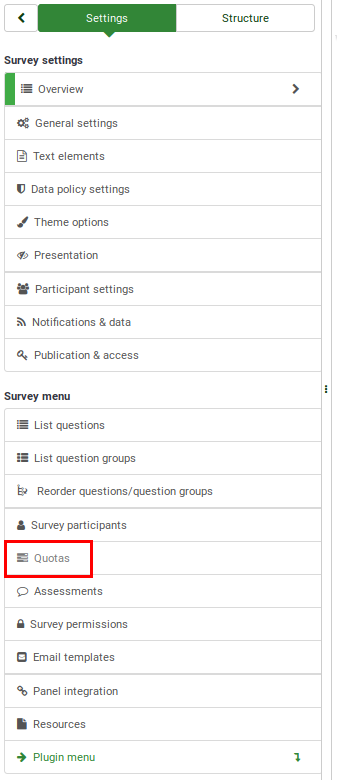
Wie funktionieren Quoten?
Um zu verstehen, wie das LimeSurvey-Quotensystem funktioniert, stellen Sie sich eine Umfrage vor, die eine "Ja oder Nein" -Frage und eine Array-Frage enthält, die jeweils zu zwei verschiedenen Fragengruppen gehören. Sie haben für diese Umfrage eine Quote festgelegt, das eine Einschränkung von 20 Benutzern enthält, die diese Frage mit "Ja" beantwortet haben. Die Quote wird jedes Mal überprüft, wenn jemand diese Frage mit "Ja" beantwortet.
Abhängig von dem Format Ihrer Umfrage (wie die Fragen Ihren Befragten angezeigt werden) erfolgt die Überprüfung beim Senden von:
- der gesamten Umfrage auf einmal: Wenn das Format der Umfrage Alle auf einer Seite ist, werden die Fragen (unabhängig von der Fragegruppe, zu der sie gehören) auf derselben Seite angezeigt. Daher muss der Benutzer den Senden-Button anklicken, um die Quotaprüfung auszulösen.
- Antworten einer Fragengruppe: Wenn das Format der Umfrage Gruppe für Gruppe ist, wird die Quote aktiviert, wenn der Umfrageteilnehmer alle Fragen beantwortet hat, die zur Fragengruppe gehören, in der sich die Antwort, die die Quotensystemprüfung enthält, befindet. Daher kann die Quote vor dem Ende der Umfrage ausgelöst werden, wenn sich beispielsweise die Fragengruppe am Anfang der Umfrage befindet.
- oder die Antwort auf eine Frage: Wenn das Format der Umfrage Frage für Frage ist, wird jede Frage separat angezeigt, wobei jeder eine Seite zugewiesen wird. Wenn Sie in diesem Fall die Antwort auswählen, auf die die Quote angewendet wird, wird das Quotensystem automatisch ausgelöst, sobald Sie auf die Schaltfläche "Weiter" / "Absenden" klicken.
Wenn "Nein" gewählt wird, wird das Quotensystem niemals ausgelöst. Daher wird die Umfrage niemanden daran hindern, den Rest der Fragen zu beantworten, sofern nicht anders angegeben.
Um ein Limit auf die Anzahl von "Nein" Antworten zu setzen, müssen Sie eine zusätzliche Quote hinzufügen und schränken die Anzahl von Teilnehmern, die „Nein" wählen.
Verwendung von weiteren Antworten und Quoten
Es könnte sein, dass Sie eine Umfrage durchführen müssen, die Sie auf 25 männliche und 30 weibliche Befragte beschränken wollen. In diesem Fall müsste Sie zwei Quoten erstellen - eine auf männlich und eine auf weiblich. Dies gibt Ihnen ein Maximum von 25 Männern, die fähig sein werden, die Umfrage zu beenden und ein Maximum von 30 Frauen, die die Umfrage abschließen können.
Nehmen wir jetzt an, Sie möchten 50 Antworten von Männern und 50 Antworten von Frauen. Bitte beachten Sie, dass jede Antwort, die das Quote auslöst, in einem eigenen Quotenfeld eingegeben werden muss. Wenn Sie die beiden Antworten in dasselbe Feld einfügen, werden unabhängig von der Geschlechterverteilung der Befragten 50 Antworten gesammelt (z. B. kann die Verteilung 40 Männer und 10 Frauen oder 20 Männer und 30 Frauen usw. umfassen). Lesen Sie auf dieser Seite weiter und lesen Sie den Unterabschnitt Beispiele, um einen Einblick in die Verwendung des Quotensystems zu erhalten.
Aktivieren des Quotensystems, wenn die Tabelle der Umfrageantworten nicht leer ist
Beachten Sie, dass ein Quotensystem nicht unbedingt hinzugefügt werden muss, bevor Sie Ihre Umfrage aktivieren. Wenn Sie das Quotensystem zu einem späteren Zeitpunkt aktivieren, wird die Tabelle mit den Umfrageantworten überprüft und nach Einträgen gesucht, die als "vollständig" markiert sind. Anschließend wird geprüft, ob die Quotenbedingung erfüllt ist oder nicht. Wenn es erfüllt ist, werden die nächsten Umfrageantworten/-einträge, die eingehen, als "unvollständig" markiert.
Wenn Sie beispielsweise zuvor 1000 Antworten von Frauen gesammelt und nach einigen Wochen das Kontingentlimit von 800 für Frauen eingeführt haben, werden die nächsten Antworten, die Sie von Frauen erhalten, als "unvollständig" markiert. Die anderen 200 Antworten werden in der Tabelle mit den Umfrageantworten als "vollständig" angezeigt, da die Quote _nach_ dem Sammeln der Antworten angewendet wurde.
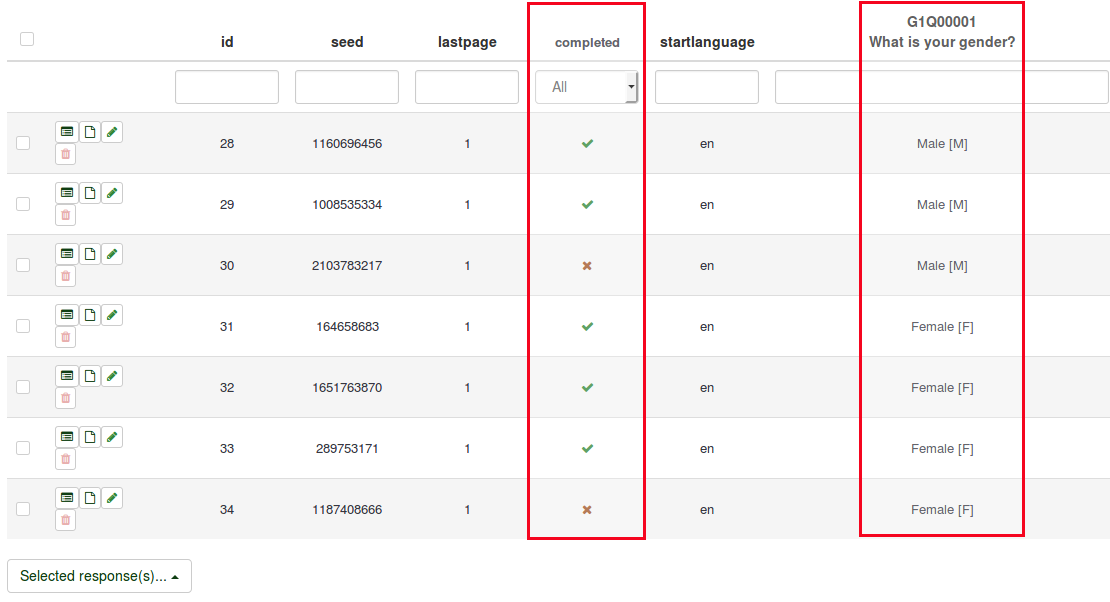
Das Quotensystem speichert keine Antworten und zeichnet nicht die Anzahl der eingereichten Umfrageantworten auf! Stellen Sie sich es als Filter vor, der auf die Tabelle der Umfrageantworten angewendet wird. Grundsätzlich werden die Spalte "Abgeschlossen" und die Ergebnisse untersucht, die Antworten enthalten, auf die ein oder mehrere Quoten angewendet werden.
Unterstützte Fragetypen
Im Moment können nur für die folgenden Fragetypen eine Quote definiert werden:
- Geschlecht
- Mehrfachoptionen
- 5 Punkteauswahl
- 10 Punkteauswahl
- Sprachschalter
- Ja/Nein
- Liste (Radio), Liste (Dropdown), Liste mit Kommentar
Umfragequotenpanel
Sobald Sie im Umfragemenü auf die Registerkarte "Umfragequoten" klicken, wird die folgende Seite geladen:

To see the full set of options of this panel, add one survey quota. Then, the survey quota page will look like the following:

The following options are available:
- Add new quota: Located on the bottom right part of the survey quotas table, it allows users to add new quotas. Once quotas are displayed on the table, you can start implementing them to certain questions/subquestions answers.
- Add an answer: Before adding an answer, you need to add a quota where the answer(s) will be stored in. The quota limit will be applied only to those answers displayed in the quota box.
- Kontingent bearbeiten: Klicken Sie auf den grünen Stift in der Spalte Aktion der Umfragequotentabelle, um die Felder einer Quote zu bearbeiten.
- Delete quota: Click the red trash button located under the Action column of the survey quotas table to delete the respective quota entry;
- Quota validation: Click the last button located under the Action column of the survey quotas table to quickly check the quota message displayed to the respondents, the URL (and/or a short description of it) where they will be redirected.
- Quick CSV report: Exports a summary of the quotas under the form of a comma-delimited CSV table.
- Selected quota(s)...: Works like an aggregator. Select multiple quotas and use this button to apply one of the actions described below to the selected group of quotas.
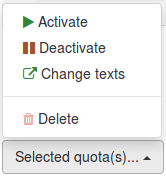
- Aktivieren: Verwenden Sie diese Schaltfläche, um eine Quote zu aktivieren. Bei aktiven Quoten wird der Name, die Aktion und die URL in weißer Schrift auf grünem Hintergrund gezeigt.

- Deactivate: Use this button to deactivate a quota. The deactivated ones have the quota name, action, and URL written in black font on a grey background.

- Change texts: Use this button to quickly change the quota message, URL, and URL description of a group of a quotas. You may use this function to redirect respondents to a certain link once different quota conditions were met.
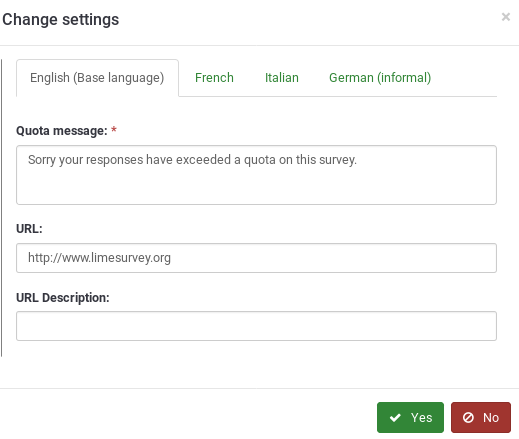
- Delete: If you want to delete a group of quotas by a few clicks, tick the ones you want to delete, click the selected quota(s) button, and select the Delete option.
Neue Quote hinzufügen
Eine neue Quote hinzuzufügen, ist tatsächlich ein Gerüst von Quotenbedingungen hinzuzufügen. Für eine vollständig aktive Quote müssen Sie dieser Quote (siehe nächsten Abschnitt) erstens „eine Quote hinzufügen" und dann „Antworten hinzufügen".
Sobald Sie auf die Schaltfläche Neues Quote hinzufügen klicken, wird die folgende Seite angezeigt:

Folgende Optionen stehen zur Verfügung:
- 'Quotenname:' Dies ist der Name der Quote, der in der Tabelle der Umfragequoten angezeigt wird. Es sollte die Quote beschreiben, die es darstellen wird;
- Quota Limit: The maximum number of completed surveys that will be stored in the responses table and marked as complete. See above the wiki section on how do quotas work to better understand the mechanism employed by LimeSurvey.
- Quota Action: If the quota is triggered, then one of two actions will happen:
- Terminate survey: This action immediately terminates and closes the survey.
- Allow user to modify his last answers before terminate survey: Useful action when you want your participants to choose different options. In this way, you can force some of them choose another solution or option. For example, when incentives are offered, you can use a quota on each option so that not everyone chooses the same incentive.
- Autoload URL: This tells LimeSurvey to automatically redirect the participant to the URL when the quota action occurs.
- Quota Message: Write the text you want to be displayed to participants if the quota action is triggered. The message will be displayed if the Autoload URL is disabled.
- URL: The URL displayed to survey participants after the quota action is triggered. The users can also be automatically redirected to this URL if "Autoload URL" is enabled. You can use URL fields in this section.
- URL Description: A short URL description can be added in order to show to the other survey administrators the purpose of the URL for example.
Antwort hinzufügen
Once the quota has been created, you can start adding answers. To add answers, access the Survey quotas panel. Look into the survey quotas table and select the Add answer option from the quota box that you want to add the respective answer to.
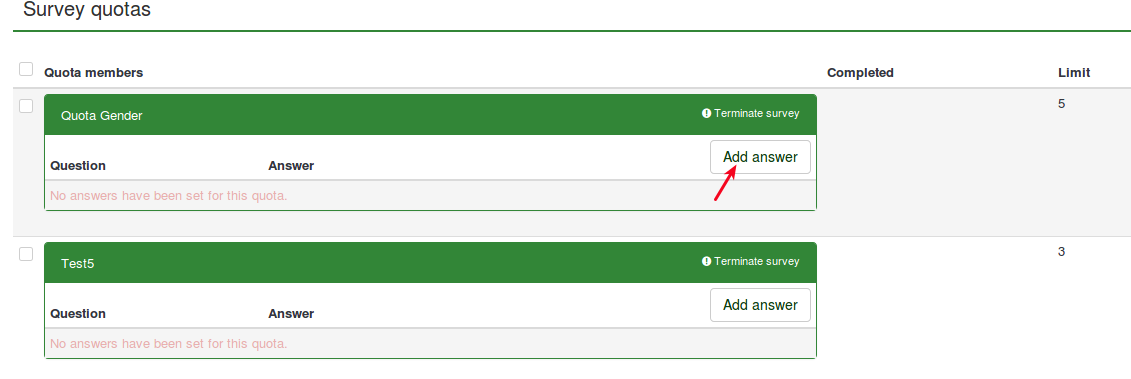
Nachdem Sie darauf geklickt haben, wird eine neue Seite geladen, auf der Sie aufgefordert werden, die Frage auszuwählen, auf die die Quote angewendet werden soll:
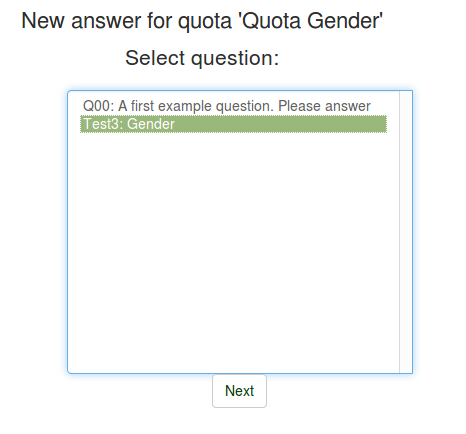
Click Next. The answers of the question you selected one step before will be displayed. Now, you have to choose which answer you want the quota to be applied to.
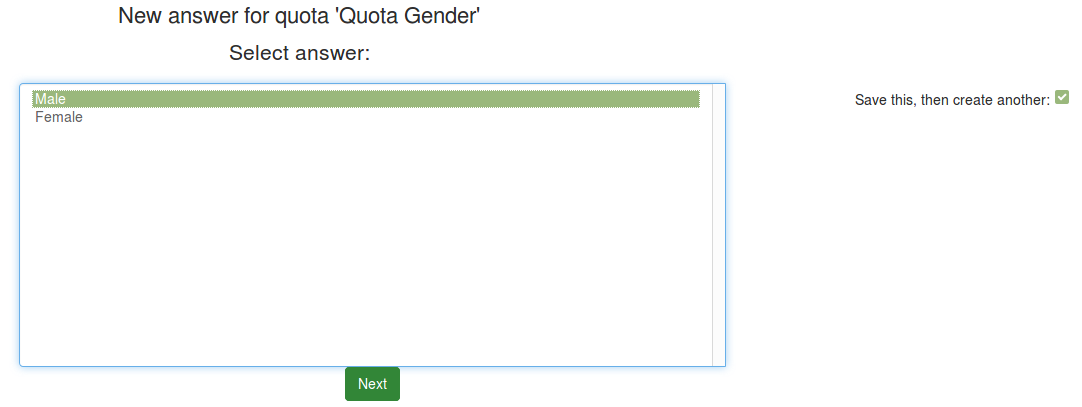
In this example, the "Male" answer will have the quota applied to it. Whenever participants choose this option, the quota system registers the answer. Once the quota limit is reached, the stored survey answers will be saved in the survey responses table, but it will be marked 'incomplete.
Quick CSV report
The quick CSV report function is used to export the survey quotas table in a comma-delimited CSV file. It includes the following fields:
- Quota name: The name of the quotas;
- Limit: If the quota is active, it represents the maximum number of survey responses that can be marked as complete in the survey responses table;
- Completed: The number of survey answers marked as complete in the survey responses table. Please note that an answer is marked as incomplete if the quota is triggered.
- Remaining: The number of answers that can still be collected in the survey responses table and marked as complete there.
Quoten und Umfrageteilnehmer
Wenn Zugangsschlüssel bei einer Umfrage verwendet werden und der Benutzer aufgrund einer Quote aussortiert wird, dann wird dies mit dem Buchstaben "Q" in der 'Beendet" Spalte markiert. Dies macht den Zugangsschlüssel ungültig und der Umfrageteilnehmer kann nicht wieder mit der Umfrage beginnen.
Beispiele
Die folgenden Beispiele sollen die Rolle von Quoten und ihre Verwendung in der LimeSurvey-Umgebung besser erläutern. Beachten Sie vor dem Lesen der folgenden Beispiele Folgendes:
- Antworten, die in derselben Quote hinzugefügt wurden, werden zusammengefasst. Wenn beispielsweise die Antworten A und B aus den verfügbaren Antworten einer Umfragefrage zu Quote Q1 hinzugefügt werden, summiert das Quotenlimit die Anzahl der Benutzer, die A oder B als Antwort auswählen. Daher ist die Verteilung der A- und B-Antworten (höchstwahrscheinlich) ungleichmäßig und hängt vollständig von den Merkmalen oder Vorlieben Ihrer Teilnehmer ab.
- Answers added in different quotas act as if there is a logical operator "AND" between them. Let's suppose that A is added to Q1 and B to Q2. If A is chosen and Q1 is reached, then respondents won't get their answers marked complete in the survey responses table. However, the survey participants that choose B are still allowed to continue as long as Q2 is not reached. Once it is reached, participants who further choose A or B as answers to that specific question will have their answers marked incomplete in the survey responses table.
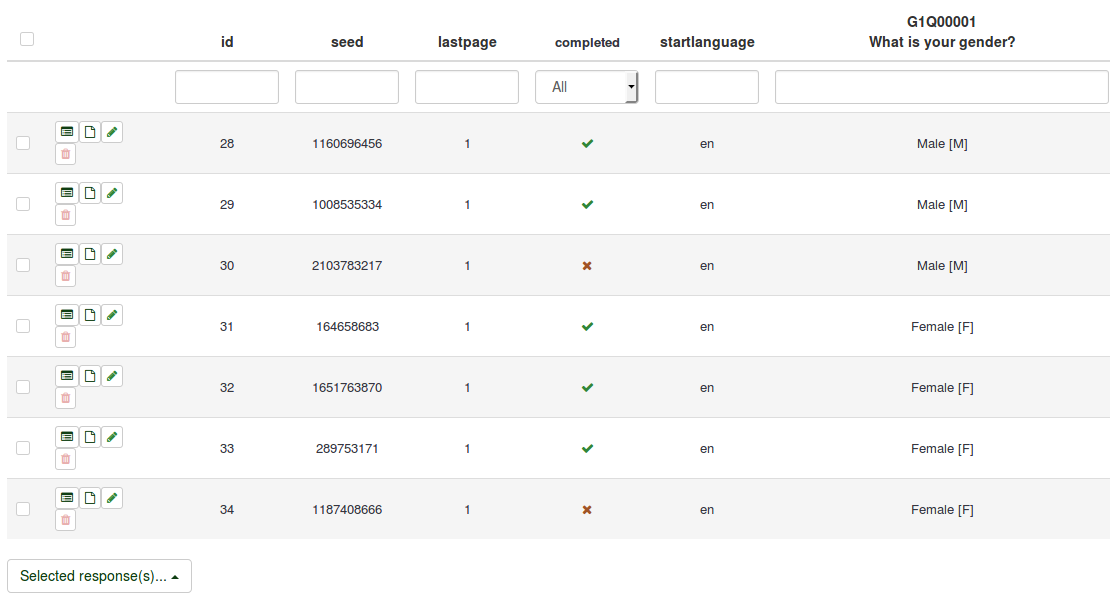
Hinzufügen weiterer Antworten zu unterschiedlichen Quoten
Let's assume that you are doing a survey about LimeSurvey and you would like to receive feedback from your participants. You would like to receive 1000 answers from students (PhD student, graduate, undergraduate) and another 1000 from non-students (unemployed persons, full/part-time working persons or other). In order to do this, create two quotas: Students quota and Non-students quota.

Now, start adding answers to each quota box following the steps described above in the wiki section. The quota boxes should look like this:

By using this method, you limit the number of responses you receive from the two defined groups: students and non-student groups. Now, activate the survey and start testing the quotas. If you first reach 1000 answers from the non-students group, the next answers you receive from this category will be marked as 'incomplete in the survey responses table. Only answers that come from the students group will still be accepted. Once it also reaches 1000, no more answers will be registered as complete in the survey responses table.
Hinzufügen eines URL-Links
To add a URL link to a quota, please continue reading the URL fields wiki section.
Verwendung des Fragetyps "Gleichung" für Quoten in einem anderen Fragetyp
You can use Equation Question to set a value to supported question types and assignment operator.
The 2 question can be hidden, quota is checked if all question are hidden or when one question is in submitted page.
For example , to set a quota to a text question (user write ok or not) on a Y/N question: {QuotaQuestion=if(strtolower(Q00.NAOK) == 'ok', 'Y', 'N')
You can import and activate this sample survey File:Limesurvey survey quotaEquationAndOptOut.zip (remember to unzip the file and activate the survey).
Like using an equation to set a value to an answer, quota for default values are checked if a question is hidden. This allows you to set a maximum number of response in a specific survey. You put a quota on the default answer in a hidden question and put this question in a simple group.
You can import and activate this sample survey File:Quota by default value sample survey.zip (remember to unzip the file and activate the survey).
